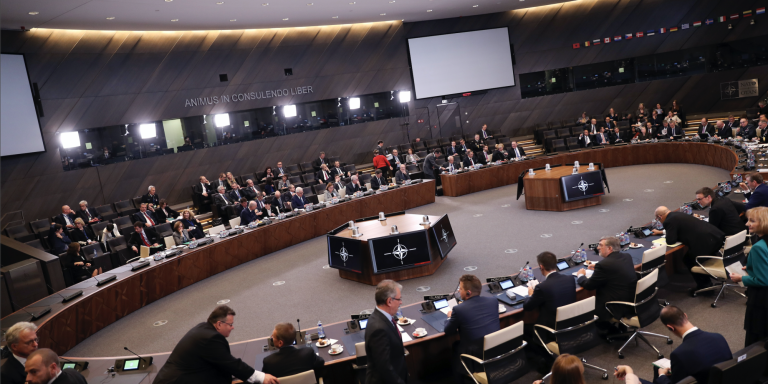INTELBRIEF
December 6, 2018
IntelBrief: A Gathering Arms Race between Great Powers

- On December 04, NATO formally accused Russia of being in violation of the Intermediate-range Nuclear Forces (INF) Treaty.
- Since 2014, the U.S. claims that Russia has developed and tested a cruise missile banned under the landmark treaty.
- Russian President Putin denied developing such a missile, but said his country will in fact pursue one if the U.S. ultimately leaves the treaty.
- There is a gathering arms race between Russia, China, and the U.S., as all three countries jockey for position in the international system’s shifting power structure.
.
Just as some scholars suggest we are moving from a unipolar system to one defined by multipolarity, a growing arms race between great powers—the U.S., Russia, and China—is a major cause for concern. Tensions between Washington and its closest near-peer competitors are increasing, exacerbated by issues like China’s aggression in the South China Sea (and other vital maritime trade routes), and Russia’s de facto invasion of Ukraine. Both of these situations threaten to upend regional and global stability. Moreover, an emerging Sino-Russian entente has further complicated a more forceful Western response. To date, the U.S. has had little success in deterring China or Russia in what those two countries see as their historic spheres of influence. As relations sour, military budgets have increased and both Beijing and Moscow have displayed a willingness to forge ahead with a new arms race.
On December 04, NATO formally accused Russia of being in deliberate and consistent violation of the 1987 Intermediate-range Nuclear Forces (INF) Treaty. That treaty banned an entire class of weapons and has largely been considered to be one of the more successful arms control treaties. However, the U.S. has stated since 2014 that Russia was in violation of the INF by building a cruise missile with capabilities specifically banned under the agreement. Russia has consistently denied the accusations, remarking that it ‘strictly abides’ by the parameters set forth in the treaty. In response to the NATO declaration, Russian President Putin said the issue really was not about what Russia was doing, noting that many other countries had developed weapons that were only banned between the U.S. and Russia. This is an obvious reference to China, which is not bound by the treaty and has developed a credible capability that arguably altered the military balance in the South China Sea, while also raising legitimate questions about the defense of Taiwan in any future potential conflict.
President Putin raised the stakes by declaring that if the U.S. exited the treaty to develop currently banned weapons, the Russian response would be to pursue a similar path. The formal declaration starts a 60-day period in which Russia must return to compliance with the INF or the U.S. will suspend its own compliance, essentially ending the 31-year old treaty. The last time the U.S. ended an arms control treaty between itself and Russia (then the Soviet Union) was in 2002, when the Bush administration abrogated the 30-year old Anti-Ballistic Missile (ABM) treaty. The U.S. made the decision to develop more robust missile ‘shields,’ systems that Russia considered a threat to the status quo.The U.S. is also modernizing its nuclear arsenal, which some had hoped would be gradually phased out as the Cold War receded. Far from cutting existing stockpiles and retaining a minimal but highly potent nuclear deterrent, the U.S. and Russia are pushing for ‘low yield’ nuclear weapons for tactical use on the battlefield—a marked break from previous administrations.
The U.S. believes, with justification, that for the last several decades it has sought to reduce its nuclear arsenal while countries like China, Russia, North Korea, Pakistan and Iran are engaged in proliferation. The Trump administration’s new nuclear policy, announced in early 2018, was an attempt by the U.S. to ‘see the world as it is, not as we wish it to be,’ as explained by Defense Secretary James Mattis. The coming years will likely see a continued acceleration of the newest arms race, potentially altering the global balance of power and introducing serious new escalation dynamics into what are already fraught relationships. These developments could thrust great power competition between nation-states back to center stage once again in international politics, while sidelining the last two decades’ worth of focus on the threat posed by non-state actors, including terrorists, insurgents, and militias.
.
For tailored research and analysis, please contact: info@thesoufancenter.org
[video width="960" height="540" mp4="https://thesoufancenter.org/wp-content/uploads/2018/12/IB-1206.mp4" poster="https://thesoufancenter.org/wp-content/uploads/2018/12/Screen-Shot-2018-12-06-at-01.27.38-1-e1544049197874.png"][/video]